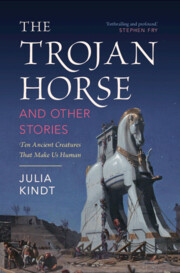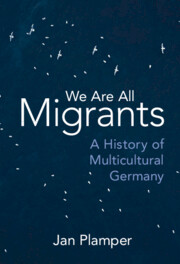92 results
7 - The Same River Twice
-
- Book:
- Medieval Riverscapes
- Published online:
- 15 March 2024
- Print publication:
- 28 March 2024, pp 243-282
-
- Chapter
- Export citation
Chapter 2 - Sensational Bodies
-
-
- Book:
- Nineteenth-Century Literature in Transition: The 1860s
- Published online:
- 01 February 2024
- Print publication:
- 08 February 2024, pp 36-56
-
- Chapter
- Export citation
Chapter 9 - Learning from Walcott
-
-
- Book:
- Race in Irish Literature and Culture
- Published online:
- 04 January 2024
- Print publication:
- 18 January 2024, pp 190-204
-
- Chapter
- Export citation
Chapter 9 - The Minotaur (Hybrida minotaurus)
-
- Book:
- The Trojan Horse and Other Stories
- Published online:
- 09 November 2023
- Print publication:
- 11 January 2024, pp 209-242
-
- Chapter
- Export citation
Chapter 5 - The Trojan Horse (Equus troianus)
-
- Book:
- The Trojan Horse and Other Stories
- Published online:
- 09 November 2023
- Print publication:
- 11 January 2024, pp 109-134
-
- Chapter
- Export citation
Chapter 1 - The Sphinx (Sphinx aenigmatica)
-
- Book:
- The Trojan Horse and Other Stories
- Published online:
- 09 November 2023
- Print publication:
- 11 January 2024, pp 13-32
-
- Chapter
-
- You have access
- HTML
- Export citation
35 - The Radical Hybridity of the Lyric Essay
- from Part IV - Toward the Contemporary American Essay (2000–2020)
-
-
- Book:
- The Cambridge History of the American Essay
- Published online:
- 28 March 2024
- Print publication:
- 14 December 2023, pp 597-611
-
- Chapter
- Export citation
Chapter 6 - Modernist
- from Part I - Literary Periods
-
-
- Book:
- The Cambridge Companion to Literature and Animals
- Published online:
- 26 October 2023
- Print publication:
- 09 November 2023, pp 112-131
-
- Chapter
- Export citation

The Trojan Horse and Other Stories
- Ten Ancient Creatures That Make Us Human
-
- Published online:
- 09 November 2023
- Print publication:
- 11 January 2024
How to ‘make law count’: Lessons from the Comisión Internacional contra la Impunidad en Guatemala (CICIG) for the Effectiveness of Hybrid Governance
-
- Journal:
- International Journal of Law in Context / Volume 19 / Issue 4 / December 2023
- Published online by Cambridge University Press:
- 18 October 2023, pp. 540-558
-
- Article
-
- You have access
- Open access
- HTML
- Export citation
23 - Distortions in the Last Frontier
- from Part VI - Global Metal
-
-
- Book:
- The Cambridge Companion to Metal Music
- Published online:
- 31 August 2023
- Print publication:
- 14 September 2023, pp 330-343
-
- Chapter
- Export citation
Hybrid Material Culture in the Inca Empire (AD 1400–1532): Analyzing the Ceramic Assemblages from La Centinela and Las Huacas, Chincha Valley
-
- Journal:
- Latin American Antiquity , First View
- Published online by Cambridge University Press:
- 14 August 2023, pp. 1-19
-
- Article
- Export citation
4 - Green Modernism
- from Part I - Methodologies
-
-
- Book:
- The Cambridge History of American Modernism
- Published online:
- 13 July 2023
- Print publication:
- 20 July 2023, pp 83-97
-
- Chapter
- Export citation
Chapter 4 - Wordsworth at Sea
-
- Book:
- Experimentalism in Wordsworth's Later Poetry
- Published online:
- 15 June 2023
- Print publication:
- 29 June 2023, pp 88-106
-
- Chapter
- Export citation
Chapter 9 - The Many Sides of Personification
-
-
- Book:
- Literary Theory and Criticism in the Later Middle Ages
- Published online:
- 20 April 2023
- Print publication:
- 20 April 2023, pp 180-205
-
- Chapter
- Export citation
Chapter 23 - Salman Rushdie and Postcolonialism
- from Part IV - Critical Theoretical Contexts
-
-
- Book:
- Salman Rushdie in Context
- Published online:
- 23 March 2023
- Print publication:
- 30 March 2023, pp 293-304
-
- Chapter
- Export citation

We Are All Migrants
- A History of Multicultural Germany
-
- Published online:
- 16 March 2023
- Print publication:
- 23 March 2023
5 - K-Pop Dance Music Video Choreography
- from Part III - Dancing to K-Pop
-
-
- Book:
- The Cambridge Companion to K-Pop
- Published online:
- 02 March 2023
- Print publication:
- 09 March 2023, pp 97-115
-
- Chapter
- Export citation
Introduction
-
-
- Book:
- Etruria and Anatolia
- Published online:
- 02 March 2023
- Print publication:
- 09 March 2023, pp 1-18
-
- Chapter
- Export citation
Chapter 14 - Alchemical Narratives
- from III - Science, Alchemy, Nature
-
-
- Book:
- A History of the Surrealist Novel
- Published online:
- 02 February 2023
- Print publication:
- 16 February 2023, pp 242-258
-
- Chapter
- Export citation



